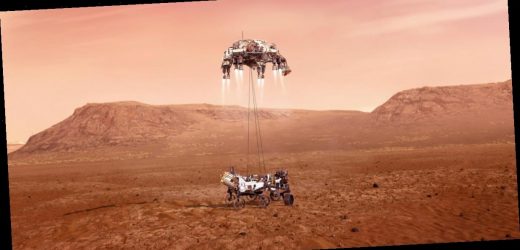- NASA’s Perseverance rover has landed in Jezero Crater, beginning a new era of exploration on Mars.
- The rover is poised to spend the next two years searching for fossils of microbial alien life.
- Perseverance carries the first interplanetary helicopter, and it will also test technologies that could help astronauts on Mars.
- Visit the Business section of Insider for more stories.
NASA’s Perseverance Mars rover has successfully landed in the red planet’s Jezero Crater.
The touchdown of the nuclear-powered robot is the first step in what could be a decade-long effort to bring the first samples of Martian rock — possibly including alien fossils — back to Earth.
The rover, lovingly nicknamed “Percy” by its engineers, launched from Cape Canaveral, Florida in July and traveled 300 million miles to Mars.
On Thursday, the capsule carrying Perseverance screamed through the Martian atmosphere at about 12,000 mph, released a 70-foot-wide parachute to slow its fall, then dropped its heat shield. That gave the rover’s cameras and radar system a view of the landscape below, which an onboard navigation system used to find a safe landing spot.
About a mile above the Martian surface, the capsule dropped the rover. A jetpack attached to the robot fired up its engines and steered Perseverance to its landing location, avoiding hazardous boulder fields, sand dunes, and 200-foot cliffs. Then the jetpack gently lowered the rover on 25-foot nylon cords until its wheels touched the ground.
At about 3:55 p.m. ET, NASA mission managers received the signal that the rover had touched down, and mission control burst into cheers and applause.
“The team is beside themselves. It’s so surreal,” Rob Manning, chief engineer at NASA’s Jet Propulsion Laboratory, said after the touchdown signal came through.
That signal was soon followed by the rover’s first two images from the Martian surface.
“We took these the second after landing. There’s still dust in the air from our landing event,” Manning said. “This is what NASA does. This is what we can do as a country.”
Perseverance is decked out with cameras and a microphone that should have recorded its entire descent — a first for a Mars landing. Initial images and thumbnail videos could reach Earth as early as this weekend. NASA engineers expect to have full video footage of the landing after a few weeks. (It takes a long time for the rover to beam all that data across space.)
A hunt for ancient alien microbes
This is NASA’s fifth Mars-rover landing, but it’s the first interplanetary mission to search for imprints of past alien life.
Perseverance is poised to spend the next two years exploring the ancient river delta that fed Mars’ Lake Jezero about 3.5 billion years ago. Back then, alien microbes may have swum in the water that filled the crater and various rivers and lakes across the Martian surface.
As the river dumped mud and minerals at the mouth of Lake Jezero, it may have trapped colonies of microbes, forming fossil rocks called stromatolites. That’s what Perseverance will look for along Jezero’s ancient lake bed, shorelines, and river delta.
But first, the rover will spend the next few weeks checking all its systems and instruments. After that, it’s set to release the first-ever interplanetary helicopter for some test flights. Once the space drone has flown, Perseverance can begin hunting for signs of long-gone alien microbes.
The rover carries 43 sample tubes so that it can stash samples of rock and soil. NASA plans to send another mission to retrieve those vials and bring them back to Earth in the 2030s.
“Samples from Mars have potential to profoundly change our understanding of the origin, evolution, and distribution of life on Earth and elsewhere in the solar system,” Lori Glaze, director of NASA’s Planetary Science Division, said in a news briefing ahead of the landing. “Even now, NASA continues to study moon samples returned by the Apollo program more than 50 years ago. We expect samples of Mars to provide new knowledge for decades to come.”
Probing the history of a desert planet
Jezero Crater is the most dangerous landing site that any Mars mission has ever targeted, but the payoff could be great. Various mineral deposits across the crater’s bed, the river delta, the ancient shorelines, and the crater rim hold a wide variety of types of rocks and soil. By collecting samples, Perseverance could help scientists learn about all kinds of environments on the red planet.
The rover carries seven science instruments that can analyze Martian rocks. It can capture images of rocks and soil in UV and visible light, probe them with radar, scan with X-rays to determine their composition, and search for organic compounds with a laser.
NASA’s Perseverance team expects the rover to gather its first samples sometime in the summer.
The robot can also move around three times faster than its predecessors, so it could cover up to 10 miles in its first Mars year (two Earth years). After that, it’s likely to get an extended mission that could take it up the crater’s 1,600-foot-tall rim. There, it would analyze the deep layers of rock cut in the Martian crust, which were exposed by a space object that struck the planet and created this crater billions of years ago. That investigation could provide insight into eons of Martian history.
Even if Perseverance finds no alien fossils, that will be important information. To date, every habitable environment on Earth that scientists have examined has hosted life.
“If we do a deep exploration of Jezero Crater with the rover and its instruments … and we find no evidence of life, we will have shown that in at least one place, there is a habitable environment that is not inhabited,” Ken Farley, the project scientist for Perseverance, said in a pre-landing briefing. “If that’s what we find, it would tell us something important: that habitability alone is not sufficient, that something else has to be present — some, perhaps, magic spark — that causes life to occur.”
Perseverance’s cargo could revolutionize space exploration
The small drone Perseverance carries is called Ingenuity. After its system checks, the rover should drive to an open field, unfold its belly panels, and lower the little helicopter for the first-ever controlled flights on another planet.
Perseverance will attempt to record video of Ingenuity’s flights. They could be the first demonstration of a new way to explore other planets.
The mission will also test technologies that could support future human expeditions to Mars. The rover’s sophisticated landing-navigation system was the first of its kind, and future Mars astronauts may rely on similar technology. Perseverance also carries a device that can convert carbon dioxide into oxygen. Called the Mars Oxygen In-Situ Resource Utilization Experiment, or MOXIE, it’s a prototype meant to test the technology on the red planet.
Oxygen is scarce in Mars’s atmosphere, and it’s unlikely that astronauts could bring enough of it to Mars to breathe there, let alone to fuel spaceships for the long journey home. So MOXIE aims to produce the crucial gas out of thin air.
The device electrochemically splits the molecules into oxygen and carbon monoxide, and combines the oxygen molecules into O2. It analyzes the product’s purity, aiming for about 99.6% O2. Then it releases both the breathable oxygen and the carbon monoxide back into Mars’ atmosphere. Future scaled-up devices would store the oxygen in tanks for astronauts and rockets to use.
Finally, Perseverance carries a small weather station to monitor dust, radiation, and weather changes on the planet — all things that future astronauts would need to keep an eye on.
Source: Read Full Article


